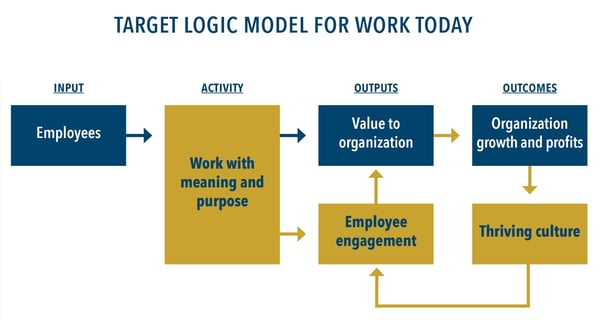.jpg?width=300&name=patrick-untersee-1160529-unsplash%20(2).jpg)
Employee engagement is a powerful determinant of an organization’s success. Employee engagement is also central to the #1 issue facing architecture and engineering firms today: employee recruitment and retention.
Unfortunately, most leaders and organizations take the wrong approach to employee engagement. Most organizations treat engagement as a “thing” – a program or an initiative, but employee engagement is not a thing for employees. As a result, there is a fundamental disconnect between engagement in the eyes of organizations and those of its employees.
Employee engagement is not about an organization or its leaders. It’s not about satisfaction, wellness, or happiness. Employee engagement is not even about the work and the work environment. Employee engagement is about how all of these work together to produce commitment and performance-boosting behaviors.
For organizations to have employee engagement, they need leaders to create the conditions for engagement and managers to help make it happen. Employees also have a role.
Designing Effective Engagement
The research is in and the results are clear. Employee engagement is good for business and good for all. Well-designed and effective employee engagement results in greater productivity and profitability, lower turnover and absenteeism, and a better work environment.
These results are outcomes based on a series of inputs, activities, and outputs done well and developed over time. How these are all connected can best be illustrated with logic models.
Below is a target logic model from my book “Reversing Burnout. How to Immediately Engage Top Talent and Grow! A Blueprint for Professionals and Business Owners.”

In the target model, the work (the activity) is designed to provide meaning and purpose with the express goal to engage the employees (the input). The employee engagement and the value provided from the work (the outputs) compounds and reinforces organizational growth and profits and the development of a thriving work culture (the outcomes).
Work with Meaning and Purpose
The key to employee engagement is to design work with meaning and purpose. Meaning and purpose needs to be from the perspective of the employee.
The work, the relationships, and the environment needs to create an emotional connection and commitment to the point where it produces “performance-boosting” behaviors. The best strategies align an employee’s interests, goals, and passions with those of the organization and those they serve.
Performance-Based Employee Engagement
Top employees, especially professionals, want to do well and excel.
Mastering our craft and making our name in the A/E industry takes time and commitment. An employee engagement strategy focused on accelerating growth and development through performance will yield greater results. As our talent moves into new work and life seasons, employee engagement also needs to evolve.
If all parties have done their jobs well, and an employee cannot be engaged through the work, there may be a “fit” issue or there may be intervening factors, such as a life event or burnout, that need to be managed or addressed.
Other Elements and Enhancements
Employee satisfaction, happiness, and wellness are all important and supportive aspects of employee engagement.
A competitive salary, benefits, bonuses, and advancement opportunities are generally able to “satisfy” employees – but that does not mean they are engaged. Many organizations never reach their full potential when they seek or only measure “employee satisfaction”.
Enhanced work environments with programs that connect us, improve health, boost morale, add safety and support, and infuse some fun are also becoming essential features of a thriving culture.
Doing Our Jobs
We all have roles in realizing the benefits of employee engagement. Below is general outline:
Leaders:
-
Have a mission that matters. Your organization and its work needs to be both inspirational and aspirational.
-
Create the conditions for engagement. Leadership is not just about strategy. To be effective today, leaders need to also own culture, sustainability, diversity, and innovation.
-
Model and incentivize the behaviors you want. “Walking the talk” is the only path to true engagement.
Managers:
-
Care about your people. No one wants to be just an employee.
-
Position yourself to succeed. You are at the center of profit and loss, client satisfaction, risk mitigation, and employee engagement. Make sure you have all the necessary training, tools, and resources.
-
Value yourself and your time. You need to keep your own “bucket full” before you can fill others’.
Employees:
-
Know what you want. Always be defining and refining your personal and professional goals.
-
Seek to excel. Is anything less really worth your time, effort, and reputation?
-
It is up to you to seek and build positive relationships. People are more inclined to help those who take initiative.
By understanding the new rules and roles for employee engagement, we can design a better approach to attract, develop, and retain top talent and realize our best future.
We will dive deeper into these new rules and our specific roles throughout this 4-part article series.
About the Author: Peter C. Atherton, P.E. is an industry insider having spent more than 20 years as a successful professional, principal, major owner, and member of the board of directors for a high-achieving A/E firm. Pete is now the President and Founder of ActionsProve, LLC (www.actionsprove.com), author of “Reversing Burnout. How to Immediately Engage Top Talent and Grow! A Blueprint for Professionals and Business Owners”, and the creator of the I.M.P.A.C.T. process.
Pete works with A/E firms to grow and advance their success through strategic planning, executive coaching, employee engagement, and corporate impact design. Connect with him at pete@actionsprove.com.



